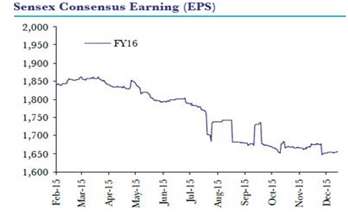It is less than a month since 2016 began, and the equity markets are already down by close to 6 per cent year to date. With this, the markets have corrected 13 per cent since the beginning of 2015 (13 months). That is good enough a correction to unnerve you a bit, or signal you to average.
It is going to be a rough ride this year, or at least for a good part of this year. China, crude oil and currency are beginning to trouble the world. But then here’s why you should not panic and upset your portfolio.
Why this is not 2008
There are many reasons why it may not be right to compare the current situation to the one in 2008. Given below are some:
First, while commodity is a factor to worry about, the scenario was entirely different in 2008. Commodity cycle was at a peak then, and was only thought to go up. This time around, if anything, commodities have crashed, and are only forecast to go further down south. That means commodity per se cannot be a threat to the net import of developing economies such as India.
Two, too much money, created too quickly and the eventual collapse of speculation in credit and derivatives in the US, besides bankcrupty in parts of Europe were key reasons for the 2008 downfall. This time, the trigger has been China, and that too its primarily slowing economy (we will discuss the China conundrum later), although it may be too early to say whether it will lead to a credit risk globally at a later stage. While a slowing Chinese economy can slow global growth, that alone need not be cause for a crisis. Besides, global growth expectations are themselves moderate, with sufficient cuts in forecasts, as opposed to unrealistic growth expectations in 2007-08. India itself has been steadily seeing earning downgrades, and there seems little optimism in near-term earnings growth. In other words, there is complete absence of exuberance. This means less risk of a bubble.
Three, various banks across the globe have been more actively using their monetary/fiscal tools to combat excess and low liquidity situations, as the case may be, since the debacle in 2008. That will also likely help curtail even a serious situation to snowball into one like 2008.
For India itself, it is among the few emerging markets considered to have a revival, helped by the fallout in commodities, as well as fiscal/monetary adjustments.
Why it will still be a tough year
While the comparison with 2008 may be overdone, we do believe that this is not going to be an easy year; at least for the next one-two quarters. Why do we think so?

What China can do: China is definitely reeling under a slowdown, following years of building over capacities. China now suffers from high savings rates, and the sinking of huge investments into capacities not balanced with productivity, therefore leading to the problem of mounting debt. There are no quick fixes for China’s woes. China’s lasting solution would come from a more open economy and market-driven currency valuation. However, allowing market forces to readjust means capital outflows (not just from China, but from other emerging markets as well), and a depreciation of the Chinese currency, renminbi, which could slowly result in global pain. This is because a depreciating renminbi could make some of the export-oriented nations less competitive. Besides, China is the second largest economy, and a slowdown there would hurt global numbers as well.
What it means for India: Many of the Asian emerging markets are exporters to China, and a Chinese slowdown could hurt them. India is less vulnerable on this count. However, a depreciating Chinese currency could make us less export competitive in our own exports such as textiles or engineered goods. Besides, cheap dumping of Chinese inputs such as steel could send Indian commodity makers into a domestic supply glut and put down corporate profitability.
Crude impact: Two, crude has bottomed to 11-year lows and is no longer driven by fundamentals. Multiple extraneous factors drive the price and removal of sanctions on Iran, and fresh supply of oil will likely not help provide any support to price.
A number of oil producing nations that have taken sharp price falls on what is their main stream of revenue could also see a slowdown in their economy. Besides crude, a number of commodities have also crashed. That means many countries such as Brazil, Russia or South Africa are hit.
As many of these oil nations are also high-importing nations, the countries that export to these regions would also be affected. There is, therefore, this ripple effect. Not that the US markets can be immune to all this as the S&P 500 gets over a third of its earnings from companies in emerging markets.
What it means for India: As mentioned early on, net importers like India get to benefit from lower crude oil prices. However, the problem is that India’s own stock market fortunes are linked to institutional flows. The outflow of sovereign wealth (belonging to oil producing nations) from oil producing nations can mean outflow of money from stock markets, thereby impacting returns. This is what is being currently experienced.
Credit risk
More than China, currency or crude, what ultimately has potential to turn a slowdown or market fall into a crisis is credit risk. Whether it is the Asian Crisis in 1997, or the global meltdown in 2008, credit holds the potential to make or break. So what is the credit risk in the current scenario? The risk with Chinese credit is imminent as its debt to GDP ratio has been mounting at over 250 per cent. And China’s credit problems can impact the world, going by its borrowings as well as its parking of money across economies.
But that is not the only credit risk. Oil producing nations could also see increasing risks in terms of a liquidity crunch. This is already visible in terms of the pull out of the sovereign wealth of gulf nations parked in other emerging markets. Oil producers including the shale gas producers in US have been under a lot of stress to service their debt as oil glut and 11-year low prices keep it hard to generate sufficient cash flows. Bankruptcy or debt restructuring could once again impact the largest sector in every economy – banking.
While this risk is not imminent at present, what we are implying is that it is effectively a credit risk that has the potential to throw the market into a 2008-like scenario. The good news is that countries are now well placed with fiscal and monetary tools to manage their liquidity better than they did in 2008. That means they have better means to curtail meltdowns. And the current scenario may also force the US to go slow on its rate hike path, thus muting the risk of outflow from riskier markets.
What it means for India: The impact on India, from such a credit situation is unlikely to show up in the economy; but rather play up in the markets. This is because, such a credit risk scenario would mean lower investible surplus in foreign institutional players including sovereign wealth money. And Indian markets are driven by foreign flows. That means, our markets may have to, for some time, settle for lower inflows or limited players participating. That would probably also be the time when domestic institutional investors (such as mutual funds) could do some bargain hunting.
Where India stands
As a net oil importer, and as one of the few emerging markets which is witnessing a revival (in pockets), India is certainly better placed to benefit from the crude oil tumble. It will fix the country’s financial problems, and also make it look even better among emerging markets.
Added to this, India is not too export driven and has a sound internal consumption story to play with. The Seventh Pay Commission, the One Rank One Pension and Direct Benefit Transfers can be expected to buttress the local economy, and signs of these are already showing up in corporate performance as well as market data.
No doubt, institutional money will flow out (before they get back into the country) as readjustment of foreign portfolios happen. However, we think such a correction is, in a way, necessary. This is because the markets heated up in the 2014 rally, with just promises of government performance, without being backed by improving corporate fundamentals.
There is more action on the ground today. And on the brighter side, the overvalued pockets on our market are beginning to get more reasonable, providing good entry opportunities. At about 19 times Nifty price earnings ratio (trailing) now, it is quite a bit of fall from the over 21 P/E even at the beginning of this year. We have (see graph below) also seen a steady downgrade in earnings estimate, unlike in 2007-08, where estimates were upped, despite P/E levels of 28 times.

So what will the markets do? Money would be rewarded to quality stocks with good earnings growth thus far, the short-term market correction notwithstanding. On the other hand, markets could be rather unkind to even small disappointments in earnings. That means there would be pockets of opportunities for fund managers to pick and hold.
What you should do
You have two choices – to sit back, watch the show (and not watch your portfolio), and thank yourself few years hence for having stayed there. Or you could hit the panic button, get out, and not just regret, but be poorer for that. We hope you will choose the former and be richer.
If you decide to average, use market falls of over 5 per cent to deploy say 2-3 months of your running SIP amounts (if you have SIPs running), or deploy a third of your surplus into the market. Large-cap or multi-cap diversified funds would be preferred options. We had advocated in September that markets would be volatile, and that investors should consider active averaging until March 2016. We believe the current scenario only provides more opportunities. So note that this will not be without short-term pain. But then, the gain at the end would likely make it worthwhile.








So, be ready to experience short term pain, to enjoy a long term gain. That seems to be the message from this interesting thought provoking article. My compliments to the author , although I seem to have read a good part of it somewhere else as well !!!
So, be ready to experience short term pain, to enjoy a long term gain. That seems to be the message from this interesting thought provoking article. My compliments to the author , although I seem to have read a good part of it somewhere else as well !!!
Vidya deserves to be complemented for this thoughtful article,contents of which can be well understood even by a person not conversant with the the subject of Economics.
Vidya deserves to be complemented for this thoughtful article,contents of which can be well understood even by a person not conversant with the the subject of Economics.
Nice article overall.
As most of the other article I have read, most of them have the same views.
In this falling market,
– Either Sit back
– Try to average out the NAVs by investing surplus.
I am mostly into this for investment into ELSS. Had SIP’s running.
As of now, I have made extra investments & am done for this financial year. Will sit back now.
Hoping for the best in Long term.
Thanks.
Nice article overall.
As most of the other article I have read, most of them have the same views.
In this falling market,
– Either Sit back
– Try to average out the NAVs by investing surplus.
I am mostly into this for investment into ELSS. Had SIP’s running.
As of now, I have made extra investments & am done for this financial year. Will sit back now.
Hoping for the best in Long term.
Thanks.
So is it the right time to start SIP to take advantage of falling market or should I wait.
Ashish, any time is a right time to start a SIP 🙂 Of course, you should further add more to a SIP in a falling market. thanks, Vidya
So is it the right time to start SIP to take advantage of falling market or should I wait.
Ashish, any time is a right time to start a SIP 🙂 Of course, you should further add more to a SIP in a falling market. thanks, Vidya